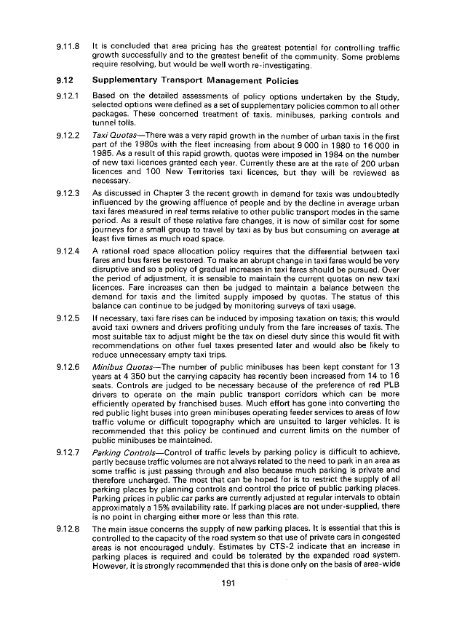Untitled - HKU Libraries - The University of Hong Kong
Untitled - HKU Libraries - The University of Hong Kong
Untitled - HKU Libraries - The University of Hong Kong
- No tags were found...
You also want an ePaper? Increase the reach of your titles
YUMPU automatically turns print PDFs into web optimized ePapers that Google loves.
9.11.8 It is concluded that area pricing has the greatest potential for controlling trafficgrowth successfully and to the greatest benefit <strong>of</strong> the community. Some problemsrequire resolving, but would be well worth re-investigating.9.12 Supplementary Transport Policies9.12.1 Based on the detailed assessments <strong>of</strong> policy options undertaken by the Study,selected options were defined as a set <strong>of</strong> supplementary policies common to ai! otherpackages. <strong>The</strong>se concerned treatment <strong>of</strong> taxis, minibuses, parking controls andtunnel tolls.9.1 2.2 Taxi Quotas—<strong>The</strong>re was a very rapid growth in the number <strong>of</strong> urban taxis in the firstpart <strong>of</strong> the 1 980s with the fleet increasing from about 9 000 in 1980 to 16 000 in1985. As a result <strong>of</strong> this rapid growth, quotas were imposed in 1984 on the number<strong>of</strong> new taxi licences granted each year. Currently these are at the rate <strong>of</strong> 200 urbanlicences and 100 New Territories taxi licences, but they will be reviewed asnecessary.9.1 2.3 As discussed in Chapter 3 the recent growth in demand for taxis was undoubtedlyinfluenced by the growing affluence <strong>of</strong> people and by the decline in average urbantaxi fares measured in real terms relative to other public transport modes in the sameperiod. As a result <strong>of</strong> these relative fare changes, it is now <strong>of</strong> similar cost for somejourneys for a small group to travel by taxi as by bus but consuming on average atleast five times as much road space.9.12.4 A rational road space allocation policy requires that the differential between taxifares and bus fares be restored. To make an abrupt change in taxi fares would be verydisruptive and so a policy <strong>of</strong> gradual increases in taxi fares should be pursued. Overthe period <strong>of</strong> adjustment, it is sensible to maintain the current quotas on new taxilicences. Fare increases can then be judged to maintain a balance between thedemand for taxis and the limited supply imposed by quotas. <strong>The</strong> status <strong>of</strong> thisbalance can continue to be judged by monitoring surveys <strong>of</strong> taxi usage.9.12.5 If necessary, taxi fare rises can be induced by imposing taxation on taxis; this wouldavoid taxi owners and drivers pr<strong>of</strong>iting unduly from the fare increases <strong>of</strong> taxis. <strong>The</strong>most suitable tax to adjust might be the tax on diesel duty since this would fit withrecommendations on other fuel taxes presented later and would also be likely toreduce unnecessary empty taxi trips.9.12.6 Minibus Quotas—<strong>The</strong> number <strong>of</strong> public minibuses has been kept constant for 13years at 4 350 but the carrying capacity has recently been increased from 14 to 16seats. Controls are judged to be necessary because <strong>of</strong> the preference <strong>of</strong> red PLBdrivers to operate on the main public transport corridors which can be moreefficiently operated by franchised buses. Much effort has gone into converting thered public light buses into green minibuses operating feeder services to areas <strong>of</strong> lowtraffic volume or difficult topography which are unsuited to larger vehicles. It isrecommended that this policy be continued and current limits on the number <strong>of</strong>public minibuses be maintained.9.12.7 Parking Controls— Control <strong>of</strong> traffic levels by parking policy is difficult to achieve,partly because traffic volumes are not always related to the need to park in an area assome traffic is just passing through and also because much parking is private andtherefore uncharged. <strong>The</strong> most that can be hoped for is to restrict the supply <strong>of</strong> allparking places by planning controls and control the price <strong>of</strong> public parking places.Parking prices in public car parks are currently adjusted at regular intervals to obtainapproximately a 1 5% availability rate. If parking places are not under-supplied, thereis no point in charging either more or less than this rate.9.12.8 <strong>The</strong> main issue concerns the supply <strong>of</strong> new parking places. It is essential that this iscontrolled to the capacity <strong>of</strong> the road system so that use <strong>of</strong> private cars in congestedareas is not encouraged unduly. Estimates by CTS-2 indicate that an increase inparking places is required and could be tolerated by the expanded road system.However, it is strongly recommended that this is done only on the basis <strong>of</strong> area-wide191
















